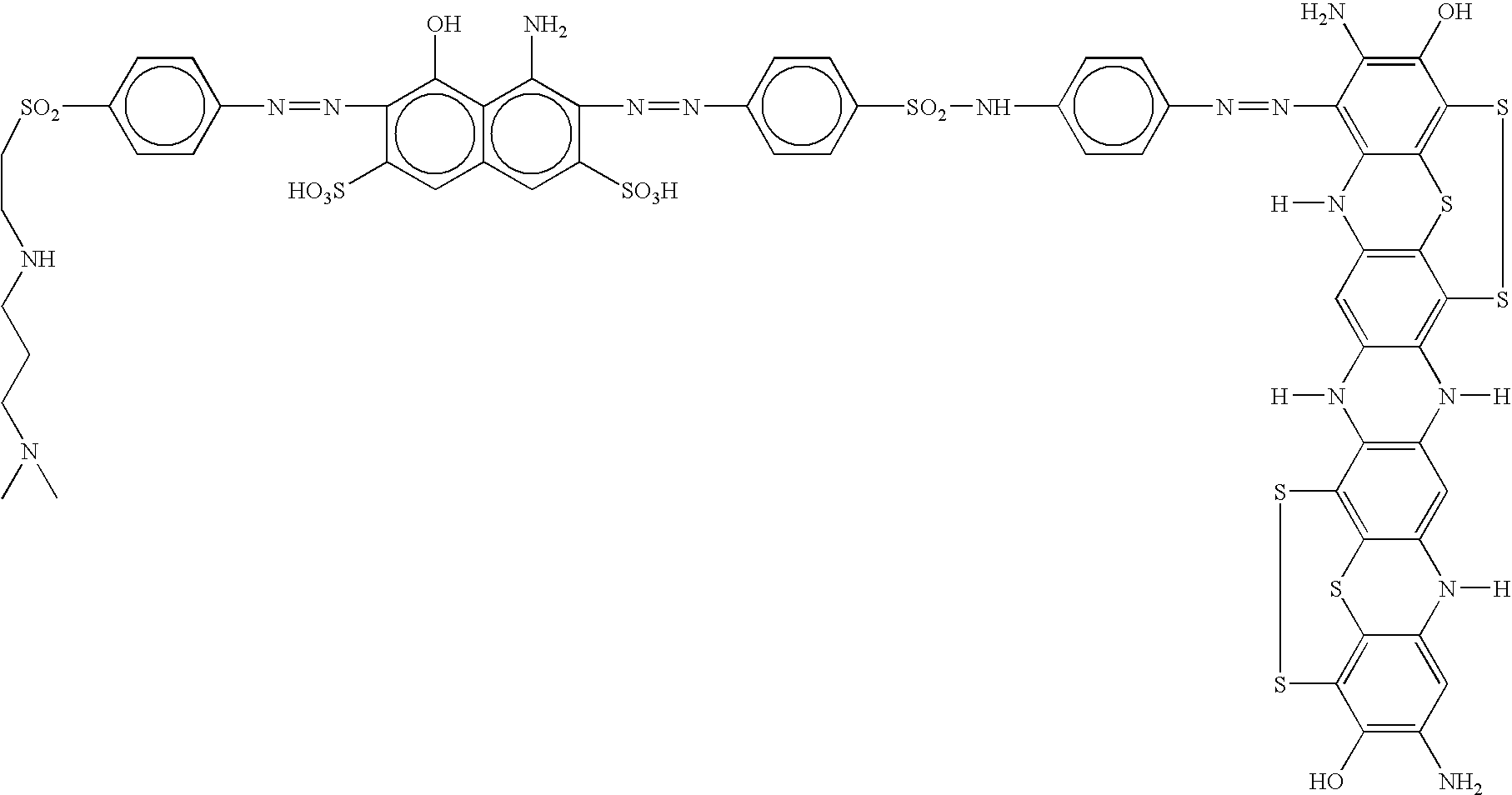New anionic coloring agents to dye leather, paper, cardboard and textile substrates: mixtures of coloring agents including these new products, and substrates dyed using the above coloring agents
- Summary
- Abstract
- Description
- Claims
- Application Information
AI Technical Summary
Problems solved by technology
Method used
Image
Examples
example 1
[0054] 38.3 parts of 2-naphtilamino-3,6,8-trisulfonic (2-naphthylamine-3,6,8-trisulfonic) acid are diazotized as usual, and coupled with 15.2 parts of 3-ureidoaniline previously dissolved in 115 parts of water at 50° C., treated with 30 parts of sodium bicarbonate and ice-cooled at 0-3° C. When the coupling is finished one part of disperser, 140 parts of ice and 19 parts of cyanuric chloride are added, and then stirred for 90 minutes at a pH of 6.5-6.7. Then, the mixture is treated with 18.8 parts of m-phenylendiamine-4-sulfonic acid dissolved in 80 parts of water with sodium hydroxide at a pH of 5.0-7.0, and then ice-cooled at 40° C. The mixture is heated at 35-40° C. and stirred for one hour, maintaining the pH at 6.5-6.7 by adding a 20% solution of sodium carbonate. The monochlorotriazinic dye obtained, is precipitated by adding a solution of sodium chloride 20% w / v. The dye is filtered and the cake is dissolved in 900 parts of water with sodium hydroxide at pH 7. 28.1 parts of 4...
example 2
[0058] 13.1 parts of e-aminocaproic acid are dissolved at a pH 10 in 100 ml of water with sodium hydroxide at 48% and are added on 28.1 parts of 4-aminophenyl-b-hydroxy-ethylsulphone sulfate ester previously dissolved in 150 parts of water at pH 7 with sodium bicarbonate. The mixture is heated at 60° C. and stirred for 1 hour. 22 parts of concentrate hydrochloric acid are added. The obtained suspension is cooled at 0° C. with ice and is diazotized with 7 parts of a solution of sodium nitrite 30%. The mixture is stirred for 1 hour at 0-3° C., and then the excess of nitrous acid is eliminated with sulfamic acid, maintaining the temperature within 0-5° C.
[0059] Separately, 31.9 parts of 4-amino-5-hydroxy-2,7-naphthalenedisulfonic acid are dissolved at pH=6.0-6.5 with sodium hydroxide in 100 parts of water, and passed drop wise on a diazo prepared from 26.3 parts of 4,4′-diaminosulfanilide according to the conventional methods.
[0060] Finished the above copulation, the resulting compou...
example 3
[0063] 31.9 parts of 4-amino-5-hydroxi-2,7-naphtalenedisulfonic acid are dissolved in 100 parts of water at a pH of 6.0 with diluted sodium hydroxide. 24.3 parts of 4-aminophenyl-N,N-dimethylpropilenediamineethylsulfone are suspended in 100 parts of water, 12 parts of 10 N hydrochloric acid are added. The slurry obtained is then ice-cooled at 0° C., and diazotized with 7 parts of sodium nitrite as a 30% solution. It is stirred for one hour at 0-3° C., and the excessive nitrous acid is eliminated with sulfamic acid. At a constant temperature of 0-5° C. the solution of 4-amino-5-hydroxy-2,7-naphthalenedisulfonic acid is added drop wise on the previous diazo, and stirred for 16 hours. Moreover, 26.3 parts of 4,4′-diaminesulfanilide are diazotized according to conventional methods. The diazo obtained is added rapidly to the previous product after being dissolved with sodium hydroxide diluted at a pH of 6.0-6.5 and ice-cooled at 0-1° C. It is then stirred for 10-15 minutes, and then its ...
PUM
 Login to View More
Login to View More Abstract
Description
Claims
Application Information
 Login to View More
Login to View More - R&D
- Intellectual Property
- Life Sciences
- Materials
- Tech Scout
- Unparalleled Data Quality
- Higher Quality Content
- 60% Fewer Hallucinations
Browse by: Latest US Patents, China's latest patents, Technical Efficacy Thesaurus, Application Domain, Technology Topic, Popular Technical Reports.
© 2025 PatSnap. All rights reserved.Legal|Privacy policy|Modern Slavery Act Transparency Statement|Sitemap|About US| Contact US: help@patsnap.com



